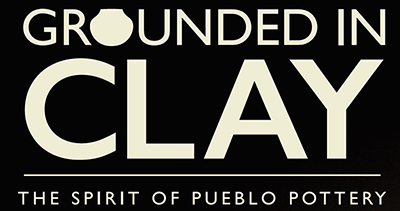Mateo Romero
Cochiti Pueblo
Curator Mateo Romero (Cochiti Pueblo) is an American artist and painter.
Mateo chose the following for the Grounded in Clay exhibit:
The World Rests on the Shoulder of Grandma’s Pot
I am going back to the time of my childhood, when my dad¹ brings us back to the rez during his summers off from being an art teacher. I think he feels it is important for us to connect with our people, though he left many years ago for a life with our mom in the Bay Area, and never seemed interested in coming back himself. Bah bah² appears indifferent to Dad, although she genuinely loves my brother and me. We are half-white, but this does not seem to matter to her at all.
My grandma lives in a HUD home³ built at the edge of the village in the 1960s: plasterboard walls, battleship-gray linoleum tiles, brown asphalt industrial tiles on the roof, and dead flies stuck to the flypaper strips in the kitchen. Like all Pueblo homes, it is spotlessly clean and immaculately maintained, with the smell of Pine Sol disinfectant and chili wafting through the house. Fresh fry bread is pulled hot from the tiny kitchen, smeared with Snow Cap lard, sprinkled with powdered sugar, and served to the half-breed urban kids visiting from the city.
It is summer, and withered, sun-bleached shrubs are visible outside the dining-room window. In the distance are the Jemez Mountains, where turbulent rainstorms build up over the peaks and with sudden ferocity rage over the village at the foot of the range. Bah bah is old, small, and brown, with silver-gray hair pulled into a bun at the back of her head and thick, black-rimmed Indian Hospital eyeglasses crowning her forehead. Her hands are a beautiful brown, veined, weathered, and filled with energy and intensity. She wears floral patterned dresses and a drab utility apron.
The entire floor of the living room is covered with pottery. Bah bah is building inventory for the summer sales. She has dug the clay and the temper, kneaded and coiled the clay, laid it out into pot forms and scraped it, slipped it with white paint and La Bajada red oxide, added designs with a yucca brush and bee-plant carbon-black paint, and finally pit-fired it in the yard with cow manure.
The pot forms are deliciously warped and eccentric. They are characterized by appliquéd, low-relief lizards on the pot shoulders, borders with no panels, Pueblo rain clouds, bee plant leaves, and pit-firing clouds. The modern, tight pottery aesthetic is totally absent from these earlier works. They are pulsing with wild lines and asymmetrical forms closer in ideology to Japanese sumi-e ink painting or 1960s New York Abstract Expressionism. These pots are alive, and they breathe. The signature and price are written on each base with a #2 Ticonderoga lead pencil: $2, $3, $6.
When we leave at the end of the summer, my grandma lets me choose a piece from the floor. I pick a black-bear figurine with comical puffy eyes. She calls him “Bee Stung Bear.” The clouds swirl outside the windows of a HUD house at the base of the Jemez Mountains, while inside, on the gray linoleum tiles, the world rests on the shoulders of Bah bah’s pottery.
¹ Santiago Holly Romero, a Cochiti Pueblo Dunn School painter from the Santa Fe Indian School movement.
² Keres male term for “grandmother.” Teresita Chavez Romero, a renowned Cochiti Pueblo polychrome revivalist potter.
³ A home built by tribes with federal funding from the US Department of Housing and Urban Development (HUD). HUD homes are often built as tract houses.

